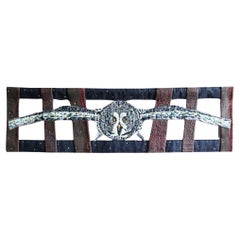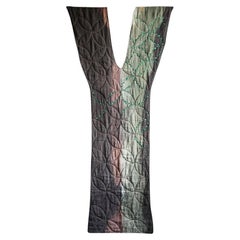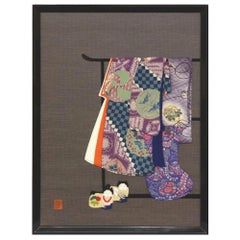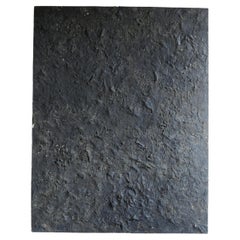Asia - Paintings and Screens
to
3
328
1,084
447
232
94
2
30
9
1
1
45
80
107
96
39
19
12
2
2
9
2
6
9
6
3
155
151
112
104
89
311
283
237
40
12
328
288
302
29
4
3
2
1
Item Ships From: Asia
Meiji-Taisho Period Buddhist Temple Cabinet Doors
Located in Fukuoka, JP
Meiji-Taisho Period Buddhist Temple Cabinet Doors
Period: Meiji-Taisho
Size: 158 x 56 cm (62.2 x 22 inches)
SKU: PTA127
Embrace serenity with these temple cabinet doors from the ea...
Category
Late 19th Century Japanese Meiji Antique Asia - Paintings and Screens
Materials
Wood
Fukurou(fuyu) by Blue Tip Atelier
Located in Sammu-shi, Chiba
Title : Fukurou (fuyu)
Japan / 2024s
Size : h 490 × w 1720 mm
An owl flapping through the winter trees is expressed through hand-painted, dyeing, quilting, and embroidery.
The mater...
Category
2010s Japanese Modern Asia - Paintings and Screens
Materials
Linen
Big Tree by Blue Tip Atelier
Located in Sammu-shi, Chiba
Title : Big Tree
Japan / 2024s
Size : w 820 × h 1950 mm
The large tree is expressed through dyeing, quilting and embroidery.
The material is fine Croatian Linen.
Hand quilted with c...
Category
2010s Japanese Modern Asia - Paintings and Screens
Materials
Linen
VIntage kimono textile art "Geometry ~Chrysanthemums" by ikasu, white, red Japan
By Kimono ikasu
Located in Setagaya City, JP
This work is inspired by traditional Japanese natural symbolism, and is framed in paulownia wood originally used for a kimono chest-of-drawers.
It is elegantly framed with paulownia...
Category
1960s Japanese Japonisme Vintage Asia - Paintings and Screens
Materials
Silk, Wood
Japanese Contemporary Framed Blue Purple Gray Silk Brocade Decorative Art
Located in Takarazuka, JP
Japanese contemporary framed three-dimensional decorative art piece in Japanese traditional silk and brocade in soft green, blue and purple on a deep gray background, recreating an 1...
Category
21st Century and Contemporary Japanese Meiji Asia - Paintings and Screens
Materials
Brocade, Silk
Tsumikasanattamono by Wataru Hatano BK
Located in Sammu-shi, Chiba
Japan / 2021s
Size : W1200 D25 H1550 mm
Kuroya Washi artist Hatano Wataru's masterpiece "Stacked Things" series. Japanese paper, soil, pigments, etc. are layered on top of each other to express the beauty of what has been accumulated over the years.
[Wataru Hatano...
Category
2010s Japanese Japonisme Asia - Paintings and Screens
Materials
Sandstone
Sawtooth by Blue Tip Atelier
Located in Sammu-shi, Chiba
Sawtooth
?Japan / 2019s
Size : W 1640 x H 2050 mm
A tribute to the traditional American quilt design made around 1840. Made with organic cotton, and indigo cotton in Alsace region ‘France. Hand dyed with chinese sumac and green leaf on the surface, and pomegranate on the back.
[Blue Tip atelier...
Category
2010s Asian Modern Asia - Paintings and Screens
Materials
Linen
Vintage obi textile art "Under the Sun ~Serendipity " by ikasu Red / Beige Japan
By Kimono ikasu
Located in Setagaya City, JP
This artwork creatively uses tree bark to evoke the imagery of woods and mountains during both the morning and nighttime on left and right. It is elegantly framed with paulownia wood, a tree closely connected to kimono culture, and is filled with storytelling and sense of luxury.
By incorporating both the front and back sides of the same obi fabric woven in different colors, the play of light and shadow on the mountains is depicted through the contrasting appearances of these surfaces.
The intention behind this piece is to convey the exquisite beauty of Japanese mountains and the lush forests that inhabit them. To achieve this, traditional elements of Japanese culture, such as obi textiles and craftsmanship involving wood, were used.
The outer side and inner linings of the same obi, no longer suitable for clothing, along with bark material that would normally be discarded, have been repurposed to create this exceptional upcycle artwork.
The fusion of Japanese natural materials – silk, paulownia wood, and pine bark for the central decoration – along with the so-called "Tozan" pattern, a unique Japanese natural design showing mountains from far-away point, captures the magnificent beauty of Japanese nature from various perspectives.
The central bark decoration stands out as a distinctive feature of this work. Pine, oak, and other tree barks are interwoven among the mountains woven into the obi, creating a tangible and authentic natural atmosphere.
<< Period / Story >>
The obi used in this piece was originally crafted during the late Showa period (1960-80ies).
<< Explanation and meaning of pattern and colors >>
This upcycle artwork uses an obi with a tozan pattern woven in two colors. The design is inspired by a distant mountain range, a motif that has been used in paintings and crafts since ancient times. However, in this particular design, the mountains are depicted not as distant peaks but as graceful semicircles giving it a mild atmosphere.
<< Characteristics of the fabric >>
This upcycled Fukuro-obi (two-side obi) showcases a festive color pattern of mountains intricately woven with gold threads against a beige front and red on the back.
The way this obi interacts with light allows it to shift in expression, much like a mountain revealing different facets over time. It can transform from deep shades of color to the appearance of gold shimmering against bright hues, depending on the lighting and viewing angle.
<< About the frame >>
Kiritansu - chest-of-drawers for kimono, is traditionally made from paulownia wood, a uniquely Japanese material closely tied to the world of kimonos.
Paulownia wood is known as the lightest wood in Japan, prased for its natural luster, resistance to moisture, and resilience against cracking. Since ancient times, it has been used in crafting furniture, chests, and musical instruments.
During the Edo period, it became customary to store cherished kimonos in paulownia chests...
Category
Late 20th Century Japanese Japonisme Asia - Paintings and Screens
Materials
Silk, Wood
Mathilda by Blue Tip Atelier
Located in Sammu-shi, Chiba
Title : Mathilda(Ⅰ,Ⅱ)
Japan / 2023s
Size : w440 x h440 mm
This quilt is made with french linen.
Hand-quilted with cotton thread.
Hand dyed with madder, chinese sumac, Japanese Pagoda Tree flower buds
and tingi (A kind of bark of mangrove).
[Blue Tip...
Category
2010s Japanese Modern Asia - Paintings and Screens
Materials
Linen
$1,200 / set
Mountains at Dawn by Blue Tip Atelier
Located in Sammu-shi, Chiba
Title : Mountains at dawn
Japan / 2022s
Size : W 990 H 1500 mm
A work inspired by the mountains at dawn.
This quilt is made with french linen.
Hand-quilted with Japanese sashiko...
Category
2010s Japanese Modern Asia - Paintings and Screens
Materials
Linen
Majestic Hawks Edo Screen by Tosa School
Located in Fukuoka, JP
Majestic Hawks Edo Screen
Period: Edo
Size: 150x168 cm (59x66 inches)
SKU: PTA93
Step back in time to the Edo period with our superb Tosa school screen d...
Category
19th Century Edo Antique Asia - Paintings and Screens
Materials
Gold Leaf
Chinese Hand Painting Birds Persimmons on Paper
Located in 景德镇市, CN
Chinese Hand Brush Painting on Paper – Birds and Persimmons, Symbolic Traditional Ink Art
Bring harmony and vitality into your space with this elegant Chinese Hand Brush Painting on...
Category
2010s Asia - Paintings and Screens
Materials
Paper
Showa Period Jinmaku Screen
Located in Fukuoka, JP
Showa Jinmaku Screen
Period: Showa
Size: 376x171 cm
SKU: PTA116
Discover the historical charm of our Showa Jinmaku screen, impeccably preserved and in extremely good condition. Jinm...
Category
20th Century Japanese Showa Asia - Paintings and Screens
Materials
Wood, Paper
Meiji Chrysanthemum Masterpiece
Located in Fukuoka, JP
Step into a world of timeless beauty with our exceptional six-panel screen from the Edo-Meiji period. In impeccable condition, each panel features stunning paintings of chrysanthemum...
Category
19th Century Japanese Meiji Antique Asia - Paintings and Screens
Materials
Gold
Taisho Period Calligraphy Screen: The Dragon's Song
Located in Fukuoka, JP
Taisho Period Calligraphy Screen: The Dragon's Song (2/2)
Period: Taisho
Size: 174 x 172.5 cm (68.5 x 67.9 inches)
SKU: PTA77
This calligraphy screen from the Taisho period is ...
Category
20th Century Japanese Taisho Asia - Paintings and Screens
Materials
Silver Leaf
Antique kimono textile art " Kobachi ~ Coral Collection ~ " by ikasu Pink, Japan
By Kimono ikasu
Located in Setagaya City, JP
This work is inspired by the coral color palette, and is framed in paulownia wood originally used for a kimono chest-of-drawers.
In this artwork, the aim was to capture the wide pal...
Category
1920s Japanese Japonisme Vintage Asia - Paintings and Screens
Materials
Silk, Wood
Miniature Mughal of Emperor Akbar And His Wife In His Courtyard, 19th Century
Located in Islamabad, PK
The Mughal miniature, meticulously created with a single-hair brush on delicate rice paper, depicts Emperor Shah Jahan in two distinct yet visually harmonious scenes with a courtesan...
Category
Mid-19th Century Indian Anglo Raj Antique Asia - Paintings and Screens
Materials
Gold Leaf
Vintage obi textile art " Camellia ~ Serendipity ~ " by ikasu Blue, Japan
By Kimono ikasu
Located in Setagaya City, JP
This work is inspired by traditional Japanese nature motifs symbolism, and is framed in paulownia wood originally used for a kimono chest-of-drawers.
In this artwork, the aim was to capture the the auspicious symbol of camellia used in antique kimono. Traditional Japanese culture, represented by the kimono, and wood, an integral element of Japanese craftsmanship, were used to bring this vision to life.
I used pieces of kimono that could no longer be used as clothing and kiritansu chest-of-drawers that would normally be discarded to create the ultimate upcycled piece.
<< Explanation and meaning of pattern and colors >>
This delicate piece features hand-drawn camellia motifs flowing gracefully on a softly brightened grayish background.
Camellias, native to Japan, bloom from winter to early spring. As an evergreen tree with green leaves throughout the year, it symbolizes the anticipation of spring and is considered an auspicious plant. Due to its seasonal significance and auspicious meanings, camellias have been used as motifs symbolizing good fortune. Additionally, they were highly valued for their use in oil, cosmetics, and medicine, representing nobility. Believed to possess the power to ward off misfortune, camellias also carry the meaning of "protection from calamity" and have strong ties to traditional ceremonies. In this artwork, camellias are delicately depicted alongside flowing branches, subtly representing good fortune with their pale pink and white hues.
"Sora-iro nezumi 空色鼠" refers to a light grayish color with a hint of blue, reminiscent of the slightly brightened sky on a lightly cloudy day. Popular during the late Edo period (19th cent.), it elegantly captures the slightly brighter sky pattern seen on lightly overcast days. Notably, the term "nezumi-iro" (mouse gray), popular during the late Edo period, was paired with brown tones, collectively known as "Forty-eight Teas and a Hundred Mice 四十八茶百鼠." Colors within the "nezumi" (gray) spectrum, particularly "sora-iro nezumi," were favored by young people for their cool and sophisticated appeal.
<< Characteristics of the fabric >>
The fabric features intricately woven patterns that reveal subtle gradations through dyeing, creating a grid pattern that transforms depending on the light conditions.
Originally, this fabric was part of a formal kimono known as a "hōmongi 訪問着," featuring motifs along the hem, shoulders, and sleeves. These motifs have been carefully selected and combined to create a unified piece of artwork.
<< About the frame >>
Kiritansu - chest-of-drawers for kimono, is traditionally made from paulownia wood, a uniquely Japanese material closely tied to the world of kimonos.
Paulownia wood is known as the lightest wood in Japan, prased for its natural luster, resistance to moisture, and resilience against cracking. Since ancient times, it has been used in crafting furniture, chests, and musical instruments.
During the Edo period, it became customary to store cherished kimonos in paulownia chests...
Category
1960s Japanese Japonisme Vintage Asia - Paintings and Screens
Materials
Silk, Wood
Vintage obi textile art "Broken Vase ~kintsugi~" by ikasu Black / Gold, Japan
By Kimono ikasu
Located in Setagaya City, JP
This textile artwork uses a vintage obi dated around 1980ies, with a feather motif, and arranges it so that it looks like a vase.
Antique obi, just as it is a broken vase, is united back again with black obijime - a string used to tie up obi when it’s worn. Framed in kiritansu (antique chest) paulownia wood.
It is elegantly framed with paulownia wood originally used for kimono chest-of-drawers, and is filled with storytelling and sense of luxury.
I used pieces of kimono that could no longer be used as clothing and kiritansu chest-of-drawers that would normally be discarded to create the ultimate upcycled piece.
<< Explanation and meaning of pattern and colors>>
Feathers hold various meanings and symbolism in Japanese traditional culture, often reflecting themes of spirituality, symbolism, and folklore. Here are some of the meanings associated with feathers in Japanese tradition:
・Divine Protection: Feathers are often seen as symbols of divine protection and spiritual guidance. Feathers, especially those from birds, are considered to be imbued with the protective energy, offering spiritual guardianship and safeguarding against negative forces.
・Connection to the Spirit World: Feathers are sometimes associated with the spirit world and the realm of the divine. In folklore and mythology, feathers are depicted as messengers between the earthly realm and the celestial realms.
・Symbol of Beauty and Elegance: Feathers are admired for their natural beauty, grace, and elegance. In traditional Japanese arts such as Noh theater, Kabuki, and dance performances like Kagura, actors and performers often use feathered costumes or accessories to enhance their appearance and convey a sense of refinement and sophistication.
・Sign of Good Luck and Prosperity: In Japanese folklore, certain birds like cranes and pheasants are considered symbols of good fortune, longevity, and prosperity. Feathers from these birds are often depicted in art and craftwork as auspicious symbols believed to bring blessings and positive energy to the bearer.
<>
Kiritansu - chest-of-drawers for kimono, is traditionally made from paulownia wood, a uniquely Japanese material closely tied to the world of kimonos.
Paulownia wood is known as the lightest wood in Japan, prased for its natural luster, resistance to moisture, and resilience against cracking. Since ancient times, it has been used in crafting furniture, chests, and musical instruments.
During the Edo period, it became customary to store cherished kimonos in paulownia chests...
Category
1980s Japanese Japonisme Vintage Asia - Paintings and Screens
Materials
Silk, Wood
Vintage kimono textile art "Fern ~Connection to Nature~" by ikasu Black , Japan
By Kimono ikasu
Located in Setagaya City, JP
This work uses an antique tomesode (festive kind of kimono) with fern design to evoke feelings of tranquility, harmony, and appreciation for the beauty of the environment. Can be used both vertically and horizontally.
It is elegantly framed with paulownia wood originally used for kimono chest-of-drawers, and is filled with storytelling and sense of luxury.
I used pieces of kimono that could no longer be used as clothing and kiritansu chest-of-drawers that would normally be discarded to create the ultimate upcycled piece.
<< Explanation of colors and patterns >>
In Japanese traditional culture, ferns, particularly the Japanese painted fern (Athyrium niponicum), hold several meanings and symbolisms:
・Elegance and Beauty: Ferns are admired for their graceful, delicate appearance and intricate leaf patterns. In Japanese aesthetics, they are appreciated for their natural beauty and are often used in gardens, landscapes, and floral arrangements to add a sense of refinement and elegance.
・Resilience and Perseverance: Ferns are known for their ability to thrive in diverse environments, including shady forests, rocky cliffs, and damp soil. Their resilience in the face of challenging conditions is seen as a symbol of endurance and perseverance. In Japanese culture, ferns may represent the ability to overcome adversity and flourish despite obstacles.
・Connection to Nature and Tranquility: Ferns are native to forested areas and are often associated with the natural world. In Japanese traditional culture, they symbolize a deep connection to nature and the importance of maintaining harmony with the environment. The lush green foliage of ferns evokes feelings of tranquility and peacefulness, making them popular motifs in Zen gardens and traditional landscape paintings.
・Purity and Simplicity: Ferns are emblematic of simplicity and purity in Japanese aesthetics. Their unassuming beauty and understated elegance reflect the principles of wabi-sabi, an aesthetic worldview that values imperfection, impermanence, and simplicity. Ferns may be used in tea ceremonies, Ikebana (flower arranging), and other traditional arts to evoke a sense of tranquility and appreciation for life's fleeting moments.
Overall, ferns in Japanese traditional culture symbolize elegance, resilience, connection to nature, purity, and simplicity. Their presence in art, literature, and landscape design underscores their enduring significance as symbols of natural beauty and spiritual resonance.
<< Characteristics of the fabric >>
This vintage textile is hand-painted with a traditional Japanese technique called "yuzen".
<< About the frame >>
Kiritansu - chest-of-drawers for kimono, is traditionally made from paulownia wood, a uniquely Japanese material closely tied to the world of kimonos.
Paulownia wood is known as the lightest wood in Japan, prased for its natural luster, resistance to moisture, and resilience against cracking. Since ancient times, it has been used in crafting furniture, chests, and musical instruments.
During the Edo period, it became customary to store cherished kimonos in paulownia chests...
Category
1960s Japanese Japonisme Vintage Asia - Paintings and Screens
Materials
Silk, Wood
Japanese Antiques 4th Head Torii Kiyotada Silk Painted Scroll, Festival, Sword
Located in Niiza, JP
Torii School Head 7th Generation [4th Generation Torii Kiyotada] Silk Painted Scroll, Festival, Sword, May
Silk Painted
Scroll head: Ceramic
box: Paulownia wood
Size: Painting size: 330 (W) x 1130 (H) [mm]
Scroll: 360 (W) x 2000 (H) [mm]
Box size: 70 x 70 x 435 mm, 600g
A large composition depicting a Japanese sword
It is thought to represent the May festival
Sekku (seasonal festival) means a day that is a turning point in the season, or a traditional event that is held on that day.
Held in May, old weapons...
Category
19th Century Japanese Antique Asia - Paintings and Screens
Materials
Silk, Paper
Chinese Handpainting Birds Flowers Painting Scroll
Located in 景德镇市, CN
Chinese paintings featuring auspicious birds and flowers are a significant genre within traditional Chinese art, often imbued with deep symbolic meanings and cultural significance.
Magpies are symbols of joy and good fortune. They are often shown in pairs to signify marital happiness. Plum blossoms symbolize resilience and perseverance. They bloom in the cold winter, representing strength in adversity. Together, they symbolize joy and the arrival of good news, often used to celebrate happy events.
Traditional Chinese bird and flower paintings...
Category
2010s Asia - Paintings and Screens
Materials
Paper
B25 Japanese Antiques CalligraphyA 6panels, Silver Paper, folding Screen
Located in Niiza, JP
Calligraphy, folding screen
Material: Paper, wooden frame
1 piece: Width 590 x Height 1700 x Depth 15 mm
Expanded size: Width 3580 mm
Folded size: Width 610 x Height 1700 x Depth 10...
Category
19th Century Japanese Antique Asia - Paintings and Screens
Materials
Paper
Chinese Ink Art Hand Brush Painting Grapes on Paper
Located in 景德镇市, CN
Chinese Hand Brush Painting on Paper – Grapes Ink Art, Traditional Calligraphy Style
Enhance your space with the timeless beauty of this Chinese Hand Brush Painting of Grapes, delic...
Category
2010s Asia - Paintings and Screens
Materials
Paper
Chinese Traditional Ink Art Hand Brush Painting Fishes Lotus Flowers on Paper
Located in 景德镇市, CN
Chinese Hand Brush Painting on Paper – Fishes and Lotus Flowers, Traditional Ink Art
Celebrate the elegance of Chinese culture with this exquisite Chinese Hand Brushpainting on Pape...
Category
2010s Asia - Paintings and Screens
Materials
Paper
Horse Racing Scene in Impressionist Style by Otto Dill
Located in Lantau, HK
Otto Dill was a German painter known for his Impressionist depictions of animals, landscapes, and equestrian sports. He was a member of the Munich Secession, a cooperative of artists...
Category
Mid-20th Century German Asia - Paintings and Screens
Materials
Canvas
Tulip Field , Holland , 2019
Located in Lantau, HK
Eliza Chui
Tulip Field, Holland, 2019
Oil on canvas, measures: 60 x 60cm.
Category
21st Century and Contemporary Asia - Paintings and Screens
Materials
Paint
Pink Tulip, 2019
Located in Lantau, HK
Eliza Chui
Pink tulip, 2019
Oil on canvas
Measures: 30 x 22 cm.
Category
21st Century and Contemporary Asia - Paintings and Screens
Materials
Paint
$2,000
Recently Viewed
View AllMore Ways To Browse
Japanese Screen Sun
Horse Panel Screen
Japanese Scroll Cranes
Mughal Screen
Japanese Scroll Kano
Gold 6 Panel Screen
Meiji Books
Gold Leaf Cranes
Japanese Floor Screens
Japanese Horse Painting
Japanese Painted Screen Floral
Geisha Screen
Japanese Tiger Screen
Painted 4 Panel Screen Chinese
Japanese Rimpa Screens
Mughal Style Painting
Hunting Screen
Japanese Dragon Screen





